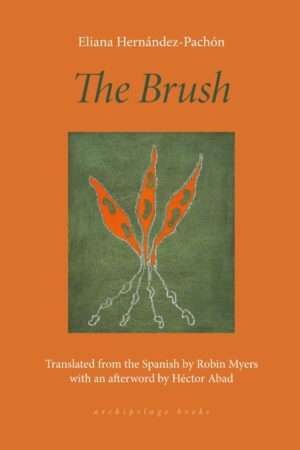The Brush
by Eliana Hernández-Pachón (translated by Robin Myers)
reviewed by Gabriella Martin
Eliana Hernández-Pachón’s long prose poem The Brush, translated by Robin Myers, begins with a portrait of rural domestic life: Pablo’s brow furrows in worry at the news, but despite a growing sense of dread, he continues to pick chamomile flowers for his wife Ester, who makes coffee in the morning and guards the secrets of their village. Pablo and Ester’s children have gone off to live in the city but their dog and cat keep them company. One night, Pablo buries a box for safekeeping in the backyard. The next day, he is gone.
The Brush bears witness to the Massacre of El Salado—one of several massacres carried out by paramilitary forces in the Montes de María region of Colombia in 2000 that was met with indifference and inaction by the government. In El Salado, the town’s residents were forced to watch sixty murders, and “as the bullets are fired, cheerful music plays … In everyone’s ears, the clamor of bullets muddles with the drumroll.” Violence, however, is not a spectacle in Hernández-Pachón’s rendering of this event. The massacre is not narrativized here, but rather it is the act of witnessing that the reader shares: we are invited to witness the act of witnessing.
The Brush is a polyphonic work, which shifts lenses from Pablo to Ester and ultimately to the landscape, but which also weaves in testimonies and questions from The Investigators and The Witnesses. This massacre evoked here is a shared trauma; thus the narrating is collective. This is not a story that could be told in a single voice or form, and the work oscillates between narrative poem, investigative questioning, and witness reports, all in under sixty pages. Its compact length allows for multiple readings, and with each new reading, more elements and historical resonances become clear—more horror comes into focus.
The translation, then, adds another layer of witnessing and recounting, as the story shifts linguistically and geographically to an audience perhaps unfamiliar with Colombian history. Robin Myers, who has heralded a wide range of contemporary Latin American authors such as Gabriela Cabezón Cámara, Isabel Zapata, and Ave Barrera, among others, in English, has taken on the act of witnessing via translation with care and grace. The book closes with a brief, moving afterword by Colombian writer Héctor Abad, in which he explores the question of “How to Narrate Horror?” by providing additional context.
Perhaps the most compelling aspect of The Brush, and what distinguishes it from other explorations of historical memory and violence, is the highlighting and inclusion of the landscape as a perspective in the collection. The titular “brush” refers to the forested backdrop of the village, presented as an active agent that also bears witness to violence: “[the] brush forgets the animals, / the rain falls harder, swallowing / the questions.” Hernández-Pachón reminds us that the human perspective is one of many possible perspectives—that the world’s processes continue despite human activity, and that
When the bodies collapse in the town square,
picked out at random,
the houses are left behind with their yards,
their kitchens, their sheets pressed smooth,
receiving, still,
the sun’s warm touch.
This decentering of the human also includes a decentering of the individual, strengthening the importance of collective grief and collective mourning, expressed explicitly with the “we” pronoun when The Witnesses ask poignant questions, such as: “If we open our mouths, will we be able to forget?” This question seems to have several others embedded within it, which are central to Hernández-Pachón’s project: What are the implications of telling? What happens to a story, or to its narrator, once it is borne witness to? Is “being able to forget” the same as not remembering?
However, Hernández-Pachón goes beyond merely including the brush’s perspective. At times the boundary between the human and nonhuman, between people and their context, collapses altogether. This reads as a decolonial move, pushing back against thought that dictates a hierarchy between humans over nature, a (masculine) domination of land. This perspective is no surprise given the author’s doctoral dissertation on Ecocuir aesthetics. The entanglement of the human and nonhuman is made evident in the linguistic affinity drawn between human bodies and the brush. Images such as “[t]he limbs crisscrossing deep inside the woods / are numberless” leave ambiguous whether “the limbs” belong to humans seeking refuge in the woods or to tree branches. Ultimately, Hernández-Pachón reminds us that it does not matter, since we’re all part of the same body:
Their bones,
their last palpable forms,
distill into erasure what
they used to be:
masses, birthmarks,
then soil and humus, simple tissue
that the weight of passing days
slowly compacts into
a coat of gauzy earth.
It is the brush (as character, as concept) that sees and knows more than any one person can. Nature serves as a model of resilience and regrowth in the face of destruction and violence. This tension between destruction and regrowth is evident in the collection’s English title: beyond the natural world, “the brush” evokes a paintbrush, which can be used to paint over something, cover something up, or sweep away a history—but also to create anew.
Published on June 26, 2024

